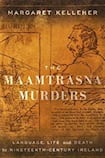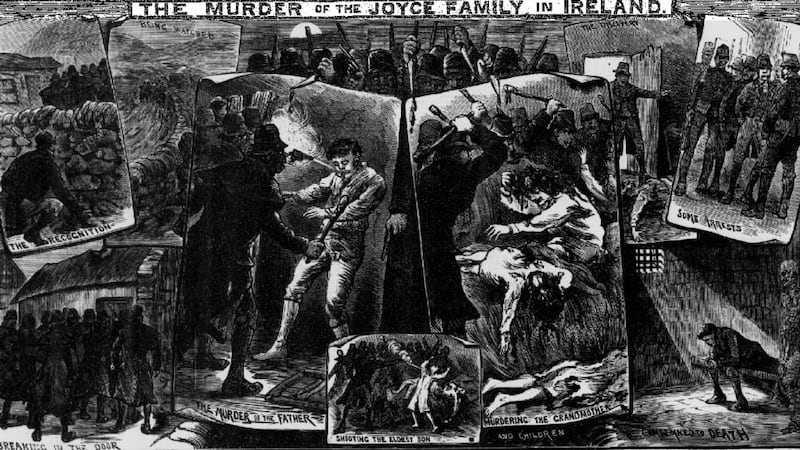
“To steal his language from a man in the very name of language,” wrote Roland Barthes, “every legal murder begins here.” The story of Maolra Seoighe (“Myles Joyce”), the Irish-speaker wrongly executed for the 1882 Maamtrasna murders after a trial conducted entirely in English, is one of the most notorious injustices in our legal history, the subject of an unprecedented pardon from President Michael D Higgins this year. Seoighe had protested his innocence to the last, desperately asking why he should be killed – “Cia’n fá mé chur ann báis?” – even as the hangman put the noose around his neck. “I couldn’t understand a word of his lingo,” recalled the executioner. It was a scene, wrote TP O’Connor, “that will live in Irish memory until the end of time”.
In her powerful and meticulous new history of the murders and their aftermaths, Margaret Kelleher illuminates not just a series of tragedies, but also the bilingual Ireland often forgotten in our narrative of language change, a messy world of two tongues where the foreign gradually became familiar in Irish mouths and minds.
The brutal murders in Maamtrasna – five members of one family killed as they slept in their own home – had shocked the nation. "This massacre," declared the weekly Irish Times, "even in the bloodstained region where it occurred, stands unequalled in all that can excite emotions of horror and indignation." That region was indeed well used to horror, subject to what a local priest described as "the heartless oppression practised towards the tenants by the landlords" who drove them "like vermin to the fringes of bogs or to the sides of mountains", where they lived in houses "more like dog-kennels than human habitations".
To many in Britain the people of Maamtrasna were what the Spectator called in its coverage "scarcely civilised beings . . . far nearer to savages than any other white men", "no higher than the Maories or other Polynesians". "Here we have a tribe", declared the Graphic, "dwelling apart from modern life, speaking a dying language, ignorant of English." Such was the profile of the murders that the lord lieutenant, Earl Spencer, visited the crime scene himself, and wrote privately to Queen Victoria that "it is incredible to believe human beings could live in such a hovel".
‘Bilingual manoeuvres’
But live they did, and die too, in a world of poverty, emigration and a linguistic revolution. “An fada go n-imeoidh an teanga Ghaelach…?” wondered Amhlaoibh Ó Súilleabháin about how long Irish would survive in 1827, but even in the 1880s the English-speaking state and society that replaced the Irish-speaking island was still under construction. Kelleher shows how we must pay more attention to the crossing of languages that characterised the 18th and 19th-centuries, a long period of “transitional bilingualism”. This was a word where translation, interpretation and “creative bilingual manoeuvres” were the norm, with people navigating encounters in whatever words they had.

Most vulnerable in this bilingual world was the Irish monoglot, a category that the sceptical state often refused to believe even existed: denying any knowledge of English was seen by many officials as a strategy to subvert the judicial process. Kelleher demonstrates how throughout the Maamtrasna trials, “who spoke what language, and by whom they were understood, mattered significantly in determining the accused’s fates”. Those with some English could negotiate the system or turn “Queen’s evidence”; those without it were reliant on translation. Meanings were disputed – did an English note of “moro” indicate marbh or marú? – interpreters were inconsistently used, and key Irish-language evidence was deliberately suppressed by a prosecution eager for convictions. Those who saw in black and white were little interested in the grey world of post-Famine Ireland, and the conflicts – over land, status, and power – that had provoked the murders of a family by its neighbours. Eight men were convicted; five were innocent.
While his brothers were sent to prison, Maolra Seoighe was among three sentenced to death, reacting to the verdict in what the bemused Daily Express called "the strange, unusual, but sonorous sounds of the mountain Gaelic". With great skill Kelleher tries to recover the traces of a lost voice fossilised in the Hiberno-English translations of bilingual interpreters and journalists: "Níl mé ciontach," he repeated, protesting his innocence. A priest or neighbour translated his pregnant wife Brighid's Irish pleas into an English letter: "I crave for mercy."
Spectres lingered
On the eve of the executions, the other two condemned men confessed to having been part of the murder party and insisted that “Myles” was innocent: “It is the greatest murder in Ireland that ever was if he is hanged,” one wrote in English, and both noted that guilty men remained free. The statements were sent to the lord lieutenant but Spencer insisted on the rigidity of modernity: “The law must take its course”.
After the executions, spectres lingered. In his 1907 essay, Ireland at the Bar (written first in Italian), James Joyce described his namesake "Myles" as a "bewildered old man, left over from a culture which is not ours, a deaf-mute before his judge . . . a symbol of the Irish nation at the bar of public opinion. Like him, she is unable to appeal to the modern conscience of England and other countries." To be understood, English seemed unavoidable for those who left and those left behind. The local young women of Maamtrasna, reported the Belfast Newsletter, sought knowledge of English "in the same way that the town-bred girl seeks proficiency at the piano". In the 1901 census, the grandchildren of the murder victims are listed as English-speaking only; two were playing in Croke Park on Bloody Sunday 1920.
Kelleher shows how the lost world of bilingual Maamtrasna continued to fascinate Joyce. "My soul frets in the shadow of his language," mused Stephen Dedalus of conversation with an Englishman; "the language in which we are speaking is his before it is mine". In Finnegans Wake, Festy King ("a child of Maam") must defend himself in Irish at an incomprehensible trial having none of the "the royal Irish vocabulary" and "murdered all the English he knew". Another Myles too found satire in tragedy: an unjust prison sentence following a trial he couldn't understand provokes Bónapárt Ó Cúnasa to pen An Béal Bocht.
At his execution in 1882, Maolra Seoighe's last words of Irish carried echoes of more than just his own murder. "On arriving at the foot of the scaffold, Myles Joyce looked up", the Galway Express reported, and stated 'Arrah thawmay glimmacht'." "Táim ag imeacht", arsa Maolra, agus d'imigh mórán eile fairis.
Dr Christopher Kissane is a historian at the London School of Economics and Political Science











